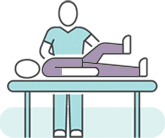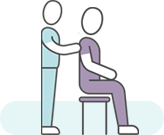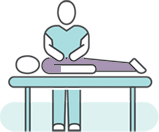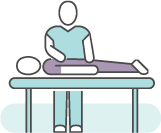Services

Kinetic Chain Release
A ground-breaking innovation in pain resolution and healthcare.
A revolutionary European approach to healthcare and pain resolution is now being offered at Bensalem Muscle Therapy. Kinetic Chain Release is a dynamic protocol which corrects a very common phenomenon - a difference in the length of a person’s legs.
According to the developer of the technique, Hugh Gilbert, a Physical Therapist from Scotland, a leg length difference, which 97% of both adults and children have, is responsible for a wide range of painful conditions in the body. Though a person may be unaware of this difference in leg length, it can be a manifestation of other imbalances in the body which result in pain and sometimes organ dysfunction.
Gilbert discovered that by unlocking specific joints and softening key muscles, the body resets itself to allow the return of normal movement and function. Kinetic Chain Release (KCR) is a series of gentle stretches and mobilizations, carefully designed to quickly and smoothly bring about postural changes that will correct the body’s imbalances in young and old alike and eliminate many physical issues in the process. It frees the body of its physical and energetic blocks to allow the return of the body to its natural state. Muscles that were previously so tight that they were pulling bones out of proper alignment, creating imbalances that lead to pain, are rapidly restored to their normal length, thereby re-establishing normal blood flow. The muscles can then function at optimum capacity, increasing apparent strength and flexibility.
Gilbert describes KCR as “the complete and lasting resolution of symptoms for thousands of people who had previously abandoned any serious consideration of recovery….Athletes from the everyday to the elite can use the KCR protocol to significantly enhance performance and maintain their edge.” In fact, he lists “GUARANTEED sports improvement” as one of the key benefits of KCR along with relief from chronic pain and increased energy levels.
A particularly compelling example is that of a nationally ranked Triathlete who had not even been able to train for 3 months and was then treated by a KCR Practitioner with the Kinetic Chain Release protocol. She received two more sessions over two weeks. Then just two weeks later, she ran in the world championships in Canada and finished in fourth place!
For more information see: kineticchainrelease.com and the Facebook Business Page – Kinetic Chain Release.

With Kinetic Chain Release, your body can be transformed from an unbalanced condition (see Figure A) to a balanced condition (see Figure B) in as little as one session.
The chart below shows a comparison between Physical Therapy (referred to as “Predicted Visits”) and Kinetic Chain Release (referred to as “Actual Visits“) in terms of the number of visits required to achieve satisfactory resolution of painful conditions of various body parts.
FOTO, the #1 organization in Physical Therapy peer review, produced this chart revealing that KCR ranked higher than 99% of all Physical Therapy outcomes on file in the U. S. And Canada. The FOTO database represents more than 4,200 clinics, 19,600 conditions, and 14.2 million patient assessments.
This represents a potential 85% decrease in healthcare costs for millions of people! If you are in pain, consider trying
Kinetic Chain Release soon!

Conditions Helped and Often Eliminated by Kinetic Chain Release
- carpal tunnel syndrome
- chronic back / neck pain
- chronic fatique syndrome
- chronic groin strains
- chronic knee problems
- fibromyalgia
- sprained ankles
- bloating
- hamstring strains
- migraine headaches
- pelvic problems
- tennis elbow
- scoliosis
- teeth clenching
- TMJ dysfunction
- Wrist Problems
- tight/cramping calf muscles
- tired/tense shoudlers
- pain between shoulder blades
- snoring/sleep apnea
- irritable bowel syndrome
- insomnia
- chronic stress
- repetitive strain injury
- breathing difficulties
- post traumatic stress disorder
- plantar fasciitis
Testimonial from Bensalem Muscle Patient who received Kinetic Chain Release
I have been suffering from migraine headaches as well as cluster headaches for the past 13 years. I have tried many types of treatments and medications with little success. Janice urged me to try Kinetic Chain Release and after just two sessions, my headaches have decreased dramatically in intensity and frequency. - S.M.
Benefits of Kinetic Chain Release
Connective Tissue Release
Adding a more profound dimension to Kinetic Chain Release.
While Kinetic Chain Release is a powerful, highly effective technique, the few people who do not respond completely can be helped with another level of therapy known as Connective Tissue Release (CTR). Also developed by Hugh Gilbert, P.T. from Scotland, CTR helps to unwind areas of connective tissue (fascia) that may have become stuck or adhered to underlying structures. CTR adds a more profound dimension to Kinetic Chain Release when it is determined that additional therapy may be beneficial.

Soft Tissue Release
A system of neuromuscular retraining based on the concepts of Swedish osteopathy.
This method, employed by a specially trained Massage Therapist and Muscle Therapy expert, involves compression of a muscle while the patient performs precise stretches in various planes. The effects are fast and permanent--reorganization of scar tissue, a return of injured muscle to its proper length, restoration of blood flow, and rapid elimination of pain.
Soft Tissue Release (STR) was developed by British sports rehabilitation therapist Stuart Taws. Taws had used the technique in his work with Olympic gold medalists and world-record holders in track and field for more than 10 years. He then refined the technique in order to broaden its applicability to chronic painful conditions. STR is so successful that up to 90% of all patients with lower back pain, regardless of the cause, can experience complete pain relief in 3 to 4 weeks.

Pfrimmer Deep Muscle Therapy
A highly refined approach to correcting damaged muscles and soft tissue throughout the body.
This unique system utilizes a cross-fiber technique, which is quite different from a Swedish massage in which the strokes flow along the fiber of the muscle. The Pfrimmer Deep Muscle Therapist concentrates on working across all layers of muscle that have become depleted of their normal blood and lymph flow. The result is a restoration of blood and lymph flow to the injured or damaged area. Blood carries the oxygen and nutrients the body needs to heal itself; lymph acts as a lubricant to tight or adhered muscles and carries away toxins that can contribute to pain when they accumulate in muscles.
The Pfrimmer Technique was developed by Therese C. Pfrimmer in the 1940s. Pfrimmer was a practicing Muscle Therapist in Ontario, Canada, when she became paralyzed. Her discovery of this method reversed her paralysis and she dedicated the rest of her life to helping others with severe disabilities and muscle conditions.
Myofascial Massage
A form of bodywork that affects the muscles and fascia of the body.
Myofascial massage is a form of bodywork that affects the muscles and fascia of the body. Fascia is a connective tissue membrane that covers muscles and each individual muscle fiber. Damage to the fascia as a result of repetitive use, stress, injury, tension, or poor posture can result in the fascia becoming “glued down” onto the underlying muscle. Such a condition can impair blood flow, thus depriving the muscle of oxygen. Additionally, nerves that normally penetrate the fascia to stimulate the muscle may become entrapped in the fascia, representing another cause of pain.
The client is an active participant in sessions where Myofascial Massage is utilized. This participation enhances both the results of the work and the client’s sense of empowerment. Fascia can be affected in several ways: pressure, warmth, breathing, and stretching. At times, the therapist applies pressure to create warmth. The client is instructed in breathing techniques and other movements are incorporated simultaneously in the process of releasing the “stuck” fascia.

Pain Neutralization Technique
A remarkable approach that quickly and painlessly releases trigger points in muscles.
Pain neutralization technique (PNT) is a remarkable approach that quickly and painlessly releases trigger points in muscles that may be contributing to a person’s pain. The therapist identifies and holds either a trigger point or an area of tension in a muscle; surrounding tissue is then manipulated in a specific way that alleviates the tension and/or the trigger point, causing the muscle to relax. Once the muscles are relaxed, the person generally experiences a significant decrease in their pain.
Sometimes an entire session is done using this method to focus on multiple muscles involved in a painful condition. At other times, Pain Neutralization Technique can be combined with other techniques or incorporated into a full body massage.
There is a small increase in fee for the latter example.
